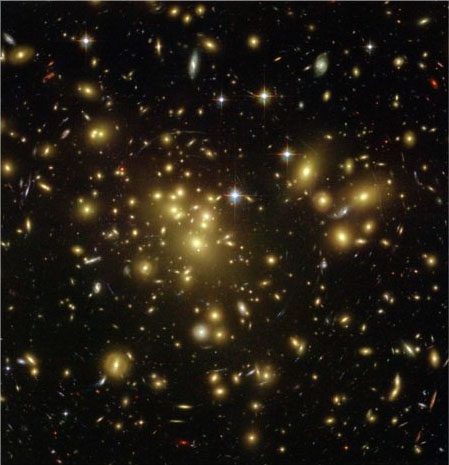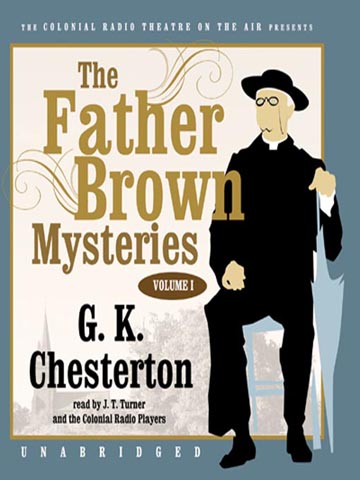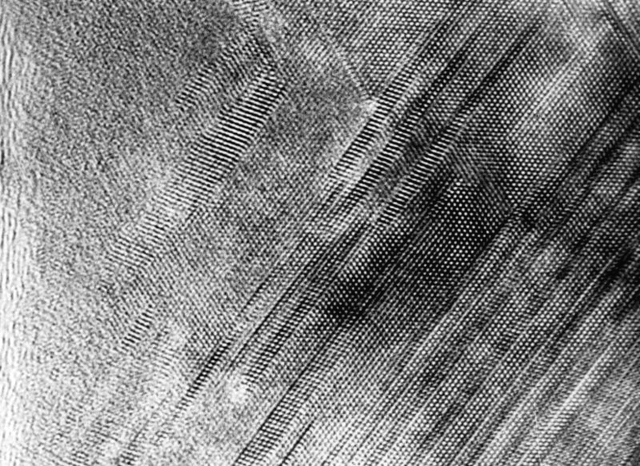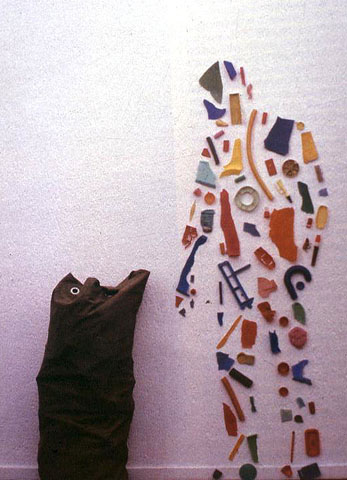This paper, originally titled: Stuff & light: paradoxes of transubstantiation in art & poetry, was given at: Language and the Scientific Imagination, 11th International Conference of the International Society for the Study of European Ideas (ISSEI), University of Helsinki, Finland, in August 2008.
 Galaxy cluster Hubble space telescope
Galaxy cluster Hubble space telescope
Paradoxically, all the stuff in the universe is, at the same time, both material and immaterial, substantial and insubstantial, determinate and indeterminate. There is a great mystery surrounding the ways in which fluid indefinite fields of energy give rise to material objects or substances. Paradoxically again, all the phenomena we would normally call the ‘stuff in the universe’, only comprises about one-tenth of the density of the universe. The other nine-tenths, often referred to as ‘dark matter’, has no luminosity and is only known due to the gravitational effects it has on other bodies.
Artworks are also polysemic, paradoxical, ambiguous – both material and immaterial – with no fixed essence and indeterminate as to definition and meaning. They manifest these qualities in a condensed fashion, drawing attention to, and celebrating, the complexity of making and interpreting.
I’m going to present a small anthology of notes about the first of these paradoxical states of existence – in which the odd things we call objects or substances are both stuff and light, matter and energy – and suggest a few correspondences between this phenomena and the manifestation of thoughts and feelings in art and poetry.
Reference will be made to Adorno, Madhyamika Buddhism, and to the literature of mysticism and sub-atomic physics.
*
In the reductive search for the ultimate ‘substance’, which was once a goal for the ‘hard’ sciences, the atom was posited as the building block out of which the universe was built – Democritus, the Greek, (c.460-c.370BC) was one of the first to believe this. But as the atom was ‘mapped’ in the early part of the twentieth century, researchers realised that the atom itself was more like a cloud than a speck of dust, a cloud that was largely empty space – a tiny field of energy bounded by the shifting trajectories of electrons, neutrons, protons and other sub-atomic forces. In Bryson’s (2004: 189) words, the atom-cloud is a ‘zone of statistical probability marking the area beyond which the electron only very seldom strays.’ Bryson (ibid: 184) also reminds us that ‘if an atom were expanded to the size of a cathedral, the nucleus [the zone of neutrons and protons] would be only about the size of a fly’. It is this concrete emptiness which lies at the paradoxical heart of our solid world. The things we bump into, the hammer that hits the nail (or our thumb) and the chair we sit on, are quite literally condensations of space that happen to reflect, refract or transmit light, and thus be visible to one apparatus or another, including the human eye. The mystery as to how indeterminate minds can be at the same time congealed-jelly-like brains, is only slightly more puzzling than how clouds of sub-atomic forces in vast numbers of almost empty porous bubbles can be at the same time a turnip.
 Gold atoms
Gold atoms
The other paradoxical feature of atoms, hardly believable, is that despite their smallness and delicate cloud-like fuzziness, they are remarkably durable. It is almost certainly the case that every atom in my body, or yours, has passed through many stars and been part of millions of other organisms before becoming me or you and passing on to be part of countless other entities. In his inimitable way, Bryson (ibid: 176) points out that atoms are so numerous and so enduring, that any or all of us, may now be composed of billions of atoms that were once part of Shakespeare, or Buddha, or Michelangelo, or, spare the thought, any human embodiment of evil you care to imagine – though it takes, apparently a number of decades before atoms come thoroughly back into circulation after they have been ‘embodied’, so to speak.
These characteristics of atoms and their sub-atomic constituents raise obvious questions about our own sense of self-ownership, self-identity and solidity. When Octavio Paz (1988: 405) in a poem entitled, Objects & Apparitions, writes of Joseph Cornell’s small box-like artworks, as:
‘Monuments to every moment,
refuse of every moment, used:
cages for infinity’,
he could have been writing about each of us. In another poem entitled, A Draft of Shadows, Paz writes of, ‘the body and its interwoven languages, / knot of phantoms touched by thought / and dissolved with a touch’. (ibid: 439) In these verbal images he conveys something of the paradoxical, and problematic, nature of our existence as embodied minds, as thinking flesh.
*
Sir Arthur Eddington:
The external world of physics has thus become a world of shadows. In removing our illusions we have removed the substance, for indeed we have seen that substance is one of the greatest of our illusions. (in Anon. 2002: 128)
*
Writing from a Sufi perspective, Shaikh ad-Darqâwî notes, ‘You are an illusion and a nothingness in a nothingness’. He goes on: ‘if you were to examine yourself, you would find God instead of finding yourself, and there would be nothing left of you but a name without a form’. (in Baker & Henry 1999: 172 – my version in modern English)
The Algerian Sufi master, Ahmad al’Alawî, (1869-1934) writes: ‘Things lie hidden in their opposites, and but for the existence of opposites, the Opposer would have no manifestation’. (in Baker & Henry 1999: 173) One wonders if there are echoes here of Derrida’s différance ?
*
Inside every apparently solid object there is an infinity of space, just as in every mind there is an imaginative infinity – though can we really speak of ‘a mind’ (for where are its boundaries) and can a mind (which is an indeterminate field of energies, firing at great speed and unfathomable complexity) have an ‘inside’?
*
The poet, Robin Blaser, (1974: 37) argues that one of the tasks of poetry (and the other arts) is to make manifest, or demonstrate, the doubled actuality of the world as stuff and light, presenting the world as a confluence of energies and forces that have no fixed boundaries – an indeterminate and transparent field of forces. Poetry and art can show us the transparency of the world we usually tend to see as opaque – even though we know it to be at the same time empty of essence and identity. In doing so, the arts also, in Heidegger’s terms, celebrate human being as a clearing or opening in which possibilities arise, challenging any idea of fixed identity. Blaser also speaks of this task as ‘the open’, (ibid: 40) and it may not be unreasonable to connect this notion with Umberto Eco’s idea of the artwork as an ‘open work’ and to go further to consider the human self or being as an open work.
*
We can approach these thoughts from another, perhaps unexpected, perspective: Adorno’s (1973) ideas about what he calls ‘negative dialectics’. It seems to me that Adorno considers one of the main purposes of his dialectical method as being to strip away all sense of categorical identities, essential truths (however provisional) and theoretical definites. He argues that while traditional western philosophy has used a variety of dialectical methods to identify or construct positive ideas, positions, theories or ‘identities’, ‘negative dialectics’ has no such purpose. Indeed even negative dialectics itself is not to be considered as a theoretical standpoint, but rather as a method for establishing or realising the fluidity and indefiniteness of all standpoints or identities – a method for demonstrating that no concept or standpoint constitutes an essential truth or autonomous identity. Thus all truths, standpoints and theories imply or invite contradiction. By implication, indefiniteness, what Adorno calls ‘nonidentity’, and contradictoriness are integral qualities of reality – or whatever cognitive field we take for ‘reality’.
One aspect of Adorno’s critique of Hegel is that Hegel uses dialectics to establish or construct ‘substantive or essential’ knowledge, whereas for Adorno, if we are to practice philosophy (and to live) in the light of the belief that there are no substantive essences, contents or identities, then we have to give up ‘the illusion that [philosophy] might confine the essence in its finite definitions’. (1973: 13) Adorno urges us ‘not to play this game’ of choosing between Yes and No, True or False, as if these qualities or attributes are absolutes or fixed essences. (ibid: 32) He also argues (ibid: 35) that: ‘Dialectics is as strictly opposed to [relativism] as to absolutism; but it does not seek a middle ground between the two; it opposes them [both] through the extremes themselves, convicts them of untruth by their own ideas. This is very similar to the methodological claims of sceptics like Pyrrho and Sextus Empiricus.
Adorno recognises that, as he puts it, ‘A dialectics no longer “glued” to identity will provoke either the charge that it is bottomless […] or the objection that it is dizzying’. (ibid: 31) But Adorno seems to value dizziness or vertigo as a positive quality: ‘In great modern poetry, vertigo has been a central feeling since Baudelaire’ (ibid) and this vertigo is an ‘index veri’ – an index of truth – which is often accompanied by ‘the shock of inconclusiveness’. (ibid: 33) So the dizzying feeling we get from engaging with the work of Baudelaire, Ezra Pound, James Joyce or Anish Kapoor may be the result of the fact that these makers realise in their work the flux of nonidentity, cutting the threads that bind us to fixed or essential viewpoints and understandings. As Adorno writes, negative dialectics does ‘not come to rest in itself’ – that is, it is always at play, resisting at every turn, reification and the craving for conclusions or answers which, in a sense, is the antithesis of art.
*
I’m reminded of Alan Schneider (1979?: 173 or Bair?) reporting that when he was once directing a play by Samuel Beckett, and trying to understand where Beckett stood in relation to one of his characters, Beckett said: ‘I take no sides. I am interested in the shape of ideas. There is a wonderful sentence in Augustine: “Do not despair; one of the thieves was saved. Do not presume; one of the thieves was damned.” That sentence has a wonderful shape. It is the shape that matters.’ We could interpret this as arguing for a kind of formalism, the sound and shape of the words and sentences as structurally meaningful, as formally autonomous. However, at another level Beckett seems to be suggesting both a kind of symmetry in our relationships to things and a ‘suspension of judgement’ (epoche) in relation to statements uttered: ‘I take no sides’.
*
To take another turn I’d like to consider a key term within Buddhist thought and practice: sunyata, or what I’ve called the mutuality of existence. (Danvers 2006)
The Sanskrit term, sunyata, is usually translated as ‘emptiness’ or ‘the void’ but this can be very misleading, as it really refers to the Buddhist insight that no entity (object or idea) exists in, or for, itself. Existence consists of a web of mutually dependent or relational phenomena – none of which have any autonomous identity or self-existence. They are empty or void of self-existence – what Adorno may mean by his term, ‘nonidentity’.
The ideas surrounding sunyata are articulated in great depth in Nagarjuna’s Sunyavada, or ‘Doctrine of the Void’, otherwise known as the Madhyamika, the “middle way” – a way that, according to Watts, “refutes all metaphysical propositions by demonstrating their relativity”.(1989, p.62) Even the idea of sunyata itself, is relative and ‘void’.
It cannot be called void or not void,
Or both or neither;
But in order to point it out,
It is called ‘the Void.’
(from the Madhyamika Shastra, in Watts 1989: 63)
This is reminiscent of Adorno’s injunction not to consider ‘negative dialectics’ as a particular philosophical standpoint but as a method for engaging with non-identity and the flux of dialectical play.
*
D.T. Suzuki: ‘In Buddhist emptiness [sunyata] there is no time, no space, no becoming, no thing-ness; it is what makes all things possible; it is a zero full of infinite possibilities; it is a void of inexhaustible contents.’ (in Anon. 2002: 128)

Perhaps, having linked ideas from physics, poetics, Adorno, Beckett and Madhyamika Buddhism, we should make another sideways leap to consider a kind of dialectical method employed by G.K. Chesterton, the half-forgotten eccentric metaphysician and author of the Father Brown stories. One word can simply characterise Chesterton’s complex metaphysics: paradox. Chesterton, in his various guises as novelist, short-story writer, poet and Catholic apologist, explores the supreme paradox: that the Many is One; and, the One is Many. He is a masterful logician and sceptical believer who uses reason to undo reasonable assumptions. As Hugh Kenner (1948: 65) notes: ‘If [Chesterton] saw two truths that seemed to contradict each other, he would take the two truths and the contradiction along with them’. There would be no question of trying to reduce the complex paradoxes of existence to what he considered to be reasonable but illogical platitudes. A lamppost is both a hard metal object and a field of light, a fact and a fiction, a mundane thing and an inexplicable mystery. Kenner again: ‘the world is a baffling place, incapable of being enmeshed in a phrase or a formula’. (ibid: 21) Chesterton accepts that there are no fixed identities, he anticipates, in many ways, Adorno’s idea of ‘nonidentity’. He sums up his own position thus:
All the straight roads of logic lead to some Bedlam, to Anarchism or to passive obedience, to treating the universe as a clockwork of matter or else as a delusion of the mind. It is only the Mystic, the man who accepts the contradictions, who can laugh and walk easily through the world. (in Kenner: 66)
In other words, it is one of the functions of art to reveal or manifest the indeterminate non-identity of how things are.
 Electron microscopy of atoms in a crystal
Electron microscopy of atoms in a crystal
When we encounter the permeable lattice of structures made by poets like Ezra Pound, W.C. Williams, Charles Olson or Anne Carson, and artists like Joseph Beuys, Dove Bradshaw, Anish Kapoor or Helen Chadwick, we are looking through the energy fields of perception, representation and language, into the energy fields of materiality, chemistry, atomic and quantum physics. The artwork is an example of poetic transubstantiation – each poem or artwork manifests a doubled or indeterminate non-identity, it is at the same time a material object and a zone of possibility, an object in space and an opening of consciousness.
*
In our engagements with artworks we are often confronted with a state of actuality that is neither this nor that, neti neti, yet also this and that, a coincidence of opposites in which truth is always plural, bifurcated, multi-facetted and diamond-like. Artworks are very beneficial partly because they often bring us to a mental clearing – a lightening of mind and being, in which we realise that there are no fixed essences or essential truths but only a network of interdependent possibilities and potentialities open to endless reformulation and change. We find art exciting and revitalising in so far as we become open to many equal and contradictory meanings – all and none of which are ‘true’. In a sense we may feel let down or constrained if we encounter an artwork that has an overt ‘meaning’ or ‘story’. The imposition of meaning or symbolic-value, by the artist or a critic, is something we tend to resist or react against. Overly didactic, dogmatic or propagandist art tends not to be valued for long, precisely because it tries to insist on one interpretation, on one fixed identity.
 Tony Cragg Figure with Kitbag 1980s
Tony Cragg Figure with Kitbag 1980s
The artwork and the self or subject can be considered as a nexus of possibilities, a dynamic space within which potential is actualised, interpretations are formed and re-formed, actions are modified and reframed, stories and images are revisioned, and beliefs and values are endlessly revised. The experiential field of the artwork is a field of liminal experience, of becoming, of betweenness, in which irreconciliable oppositions are recognised and handled as manifestations of the indeterminacy and mutuality of existence. This view of art as a zone of interpretation and transubstantiation, and as a nexus of possibilities, is radically different to the notion of art as a zone of truth – a place, or object, in which a truth resides or is revealed.
In our encounters with artworks we encounter the paradox of transubstantiation, the uncomfortable realisation that things are both stuff and light, not this or that, but this and that – many things at once. Empty of essence, and indeterminate as to meaning and identity, artworks are a challenge to any tendency towards dogmatism, reductionism and reification. What we look for in artworks is, at the very least, many possible meanings, a zone of interpretative possibility in which ideas about truth are contested or presented in a complex way, or in which our usual notions or assumptions are challenged and our tendency towards binary judgements (true/false, right/wrong, good/bad) are suspended. In being open to many interpretations we are liberated from the dictatorship of one, and are thus empowered. We become, for a time at least, more porous, transparent and open, able to suspend judgement for a time and to enjoy the unpredictable play of sensations, ideas and the intermingling of minds.
Perhaps it would be useful to carry these ways of thinking and being out of the art gallery or concert hall and use them to live with the conflicts and uncertainties that confront us in the complex uncertain world outside.
***
Bibliography
Adorno, T. 1973. Negative Dialectics, London: Routledge & Kegan Paul.
Anon. 2002. Afterword in Tricycle, Spring 2002.
Bair, D. 1980. Samuel Beckett: A Biography, London: ???
Baker, B. & Henry, G. eds. 1999. Merton and Sufism: The Untold Story – A Complete Compendium, Louisville Kentucky, Fons Vitae.
Blaser, Robin. 1974. ‘The Metaphysics of Light’ in The Capilano Review 6 (Fall): 35-62.
Bryson, B. 2004. A Short History of Nearly Everything, London: Black Swan.
Danvers, J. 2006. Picturing Mind: Paradox, Indeterminacy and Consciousness in Art & Poetry, Amsterdam: Rodopi
Kenner, H. 1948. Paradox in Chesterton, London: Sheed & Ward.
Paz, O. 1988. Octavio Paz: Collected Poems 1957-1987, Manchester, UK: Carcanet.
Watts, Alan. 1989. The Way of Zen. New York: Vintage Books.